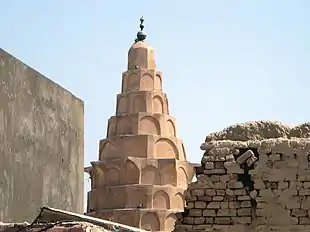Al-Nukhailah Mosque
An-Nukhailah Mosque (Arabic: مسجد النخيلة) is an historic Shi'ite Islam mosque in the town of Al Kifl, Iraq. The mosque is a complex which contains the Dhu'l Kifl Shrine (Arabic: مرقد نبي الله ذي الكفل), which is believed to be the tomb of the prophet Dhul-Kifl, who is considered to be Ezekiel.
| An-Nukhailah Mosque | |
|---|---|
Arabic: مسجد النخيلة | |
 Dhu'l Kifl Shrine, a part of An-Nukahilah Mosque | |
| Religion | |
| Affiliation | Islam |
| Rite | Shi'ite |
| Ecclesiastical or organisational status | Mosque and shrine |
| Status | Active |
| Location | |
| Location | Al Kifl, Iraq |
 Location in Iraq | |
| Geographic coordinates | 32.2267908°N 44.3670540°E |
| Architecture | |
| Type | Islamic architecture |
| Completed | 1316 CE |
| Specifications | |
| Dome(s) | 1 |
| Dome height (outer) | 20 metres (66 ft) |
| Shrine(s) | 1 |
History
The complex was originally a pilgrimage site for Jews as it contained the tomb of the prophet Ezekiel, built back in the 7th century.[1] However, some narratives consider that the site has its roots on the shrine built by the prophet Abraham, indicated by the description of Imam al-Mahdi by Muhammad al-Jawad, the ninth of the Twelve Imams is the Twelver Shia Islam.[2] In 1316, the Ilkhanid Sultan Öljaitü acquired the right of guardianship over the tomb. Since then the site was restored, and renamed according to the Islamic tradition and developed as an Islamic religious site. Minarets and the mosque were erected in the same period.[1] In a smaller room, it contains four tombs of Ezekiel's companions and tombs of the Geonim, as well as a cenotaph to Baruch ben Neriah.
In 2014, the site, especially the minarets, were restored by the Iranian companies and the Waqf of the Shi’a community, which cost approximately 800 million dinars.[3]
Architecture
The unique dome of the tomb has muqarnas adorned inside, and mimics the honeycomb pattern on the outside. The surface and the upper part of the wall is painted with polychrome pattern from the Ottoman period.[1] It reaches 20 metres (66 ft) high and sits on the foundation of 4 cubic metres (140 cu ft).[2]
References
- Dhu'l Kifl Shrine. Archnet. Retrieved January 10, 2018.
- مسجد النخيلة التاريخي. مركز التراث البصرة. Retrieved January 11, 2018.
- افتتاح منارة مسجد (النخيلة) التاريخي بالقرب من "ضريح الكفل" بعد تأهيلها بكلفة مليار و800 مليون دينار Archived 2018-06-21 at the Wayback Machine. Al-Mada Press. Retrieved January 11, 2018.
Bibliography
- Al-Janab Tariq Jawad (1982). Studies in Medieval Iraqi Architecture. Baghdad: Ministry of culture and Information, State Organization of Antiquities and Heritage. pp. 96–105.
- Michell, George, ed. (1978). Architecture of the Islamic World. London: Thames and Hudson. p. 246.
External links
- Official Website of An-Nukhailah Mosque
- INSIDE EZEKIEL SHRINE. Babylon Jews. Retrieved January 11, 2018.

.jpg.webp)